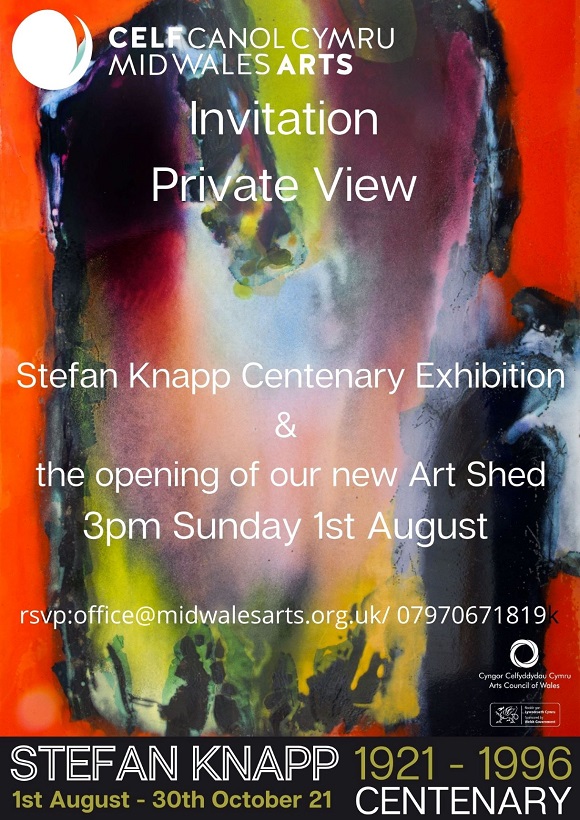Mid Wales Arts Centre are pleased to announce the Centenary Exhibition of Stefan Knapp (1921-1996) in the New Art Shed.
 In preparation for this exhibition, the Sculpture Hall at Mid Wales Arts Centre has been completely rebuilt to become a big new contemporary accessible art space suitable for the exhibition of large-scale artwork right in the heart of Wales. MWA gratefully acknowledges the support of the Arts Council of Wales and Lottery Funding whose generous match funding contribution have made this possible.
In preparation for this exhibition, the Sculpture Hall at Mid Wales Arts Centre has been completely rebuilt to become a big new contemporary accessible art space suitable for the exhibition of large-scale artwork right in the heart of Wales. MWA gratefully acknowledges the support of the Arts Council of Wales and Lottery Funding whose generous match funding contribution have made this possible.
Bringing Stefan Knapp’s extensive permanent collection and archive to Wales was the foundation for Mid Wales Arts Centre, this exhibition celebrates his extraordinary achievements and legacy. He was born in the small country town of Bilgoraj in south-eastern Poland in 1921 and is best known for his vibrant enamel murals which can be seen in many museums and public buildings throughout the world. Knapp was the first artist to experiment with enamel on steel, especially on a large scale.
This exciting exhibition tells the story of Stefan’s life through his art and how despite suffering all the pain and trauma the 20th century could throw at him he emerged as an innovative, technologically brilliant artist whose work conveys understanding, compassion, humour and rejoicing in the forms, materials and colours in our world. It is a story relevant to the present moment of how art can provide a vehicle to express and overcome haunting memories and fears.
In 1939 aged just 18 he was arrested and endured 3 years imprisonment in a Siberian labour camp. He was released In 1942 following the Stalin Churchill agreement and made the frightening journey on foot and boat via South Africa to the UK, where he trained to be a Spitfire pilot in the Polish RAF, becoming a Flight Lieutenant making reconnaissance sorties in Italy where his logs detail praise for his above average ability.
In 1945 he enrolled at Central School of Art, supporting himself in post war London through his survival instinct and talent. He quickly made a name for himself as an outstanding student, attending the Slade simultaneously, he organised Young Artist Exhibitions and won commissions. These included prestigious ones for John Lewis and Bentalls. His interest in design led him to experiment and invent a new type of spherical lampshade, featured in Vogue and Cyril Lord paid him £1000 for the patent. This gave him the security to devote himself to painting.
He was determined to find his own style, first he painted out his nightmares and there are paintings in the exhibition describe the horrors of man’s inhumanity to man that he witnessed.
He painted and threw away, painted and threw away until he felt he had found a visual and emotional voice that was strong enough to express his ideas.
The result was a sell out exhibition in 1954 at Erica Brazen’s Hanover Gallery, London, which had rave reviews. He began experimenting with enamel, making 3D bronze casts of the images and creatures that inhabited his paintings, they were cast in Paris and he was invited to show with Pierre Matisse Gallery New York and Gunther Franke in Munich the following year.
Stefan was the first person to enamel on steel instead of copper, this enabled him to make large scale murals all over the world. He was commissioned by St Anne’s College Oxford, Heathrow Airport, the Rowney Building and many, many more. A section of the Heathrow mural will be on display in this exhibition.
In 1958 Stefan was one of four artists commissioned by Mies Van der Rohe and Philip Johnson to create large scale work for New York’s iconic Seagram building along with Picasso, Miro and Bertoia.
His huge imagination, energy and capacity for work led to a flood of commissions, from all over the world, he worked closely with architects such as Sir Denys Lasdun on the Paddington School Mural, Paul Getty visted his studio and he was asked by George Farkas, President of Alexanders Dept stores in New York…How big can you paint?
The result was the biggest painting in the world, the subject matter related to his aeriel view of the world without borders’ ‘ It was reported in newspapers all over the world, featured the cover of Time magazine and Pathe newsreels.
Having gained an international reputation, Stefan was privileged to re-enter Poland, then part of the Eastern bloc and was able to reconnect with his Polish family. He made large murals for the University of Torun and the Copernicus Museum in Olsztyn that are still celebrated today.
Awards:
1945 Virtuti Militari
1973 Churchill Fellowship Award
1975 Knight of the Cross Polonia Restituta
1988 Medal of Merit for Polish Culture
Always an individual, true to his understanding of the depth of human nature and the natural world he continued to develop, codify and translate his impressions into forms and symbols that re emerge throughout his work. He would start with a sketch, then draw in detail, his symbolism translated into paintings, an enamels and sculpture.
He led a colourful life during an exciting time in Art History, he died in 1996 days after the reinstatement of one of his Heathrow murals in the terminal 4 transit building designed by Sir Richard Rogers.
Open from 5th August 2021 – … 2021. Thurs-Sun 10-4. Entrance is free. No advance booking needed.












